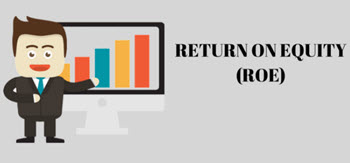‘Return on equity’, also known as ROE (or ‘return on net worth’), measures how well a company can turn a profit from the investments made by its shareholders. Therefore, it is an important thing to look at for any shareholders who are potentially looking to invest in a company.
So, a return on 1 would mean that 1 Euro of net income for the company is generated for every 1 Euro of stockholders’ equity.
This is essential information for any investors who are looking to invest in a company – the calculation used for return on equity shows how well, or not, a company turns invested money into income.
The Formula
 The formula used to work out return on equity is simple to work out: it is the net income of a company divided by the shareholders’ equity. So, if you have invested in a company that has a net income of €15 million, and shareholders’ equity (also known as net worth) of €60 million, then the calculation is as follows:
The formula used to work out return on equity is simple to work out: it is the net income of a company divided by the shareholders’ equity. So, if you have invested in a company that has a net income of €15 million, and shareholders’ equity (also known as net worth) of €60 million, then the calculation is as follows:
15 million/60 million
15/60 is 0.25, that is, 25%. So, for every euro invested by a potential shareholder, the company will return a 25% on equity – €0.25 net profit.
Is Higher Always Better?
25% would certainly be a very good return on equity; anything over 15% is generally seen as good. If a company has a high return on equity, they are increasing their ability to make a profit without needing as much money to do so. If a company has a lower return on equity, then the opposite can be said. However, is it as simple as saying that the higher the return on equity, the better? Not quite, and not in all cases.
A low return on equity shouldn’t necessarily signal alarm bells for potential investors in a company. There are many and various factors as to why a company has a low return on equity. For example, a company may have recently purchased some essentials after receiving an injection of some equity. Therefore, in the short-term the return on equity may appear low. It is important, then, to look at the long-term when you’re looking at a company’s return on equity. A company that can provide a consistent high return on equity over many years is also one that will probably provide consistent returns for an investor.
Something else to note is that the return on equity can rise as the values of shareholders’ equity decreases. Another way in which the return of equity is artificially increased is by high levels of debt – the more a company is in debt then the lower the level of shareholders’ equity.
Comparing Returns on Equity
If you are a potential investor and comparing returns on equity in different companies, it is important to do so only with companies who operate within the same industry. This is because there are large fluctuations between different industries in terms of investment and income. Therefore, you’ll get a better idea if it’s wise to invest in a company by remaining industry-specific. What may be a high return on equity in one industry may be considered low in another, so context should always be taken into account.
This article was last updated on: January 28, 2018
